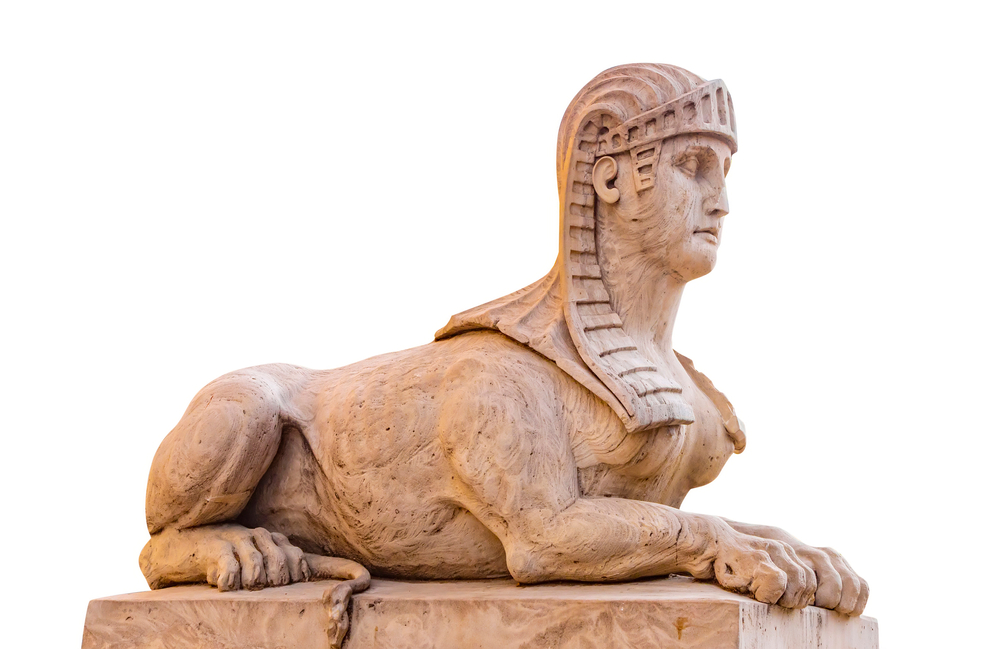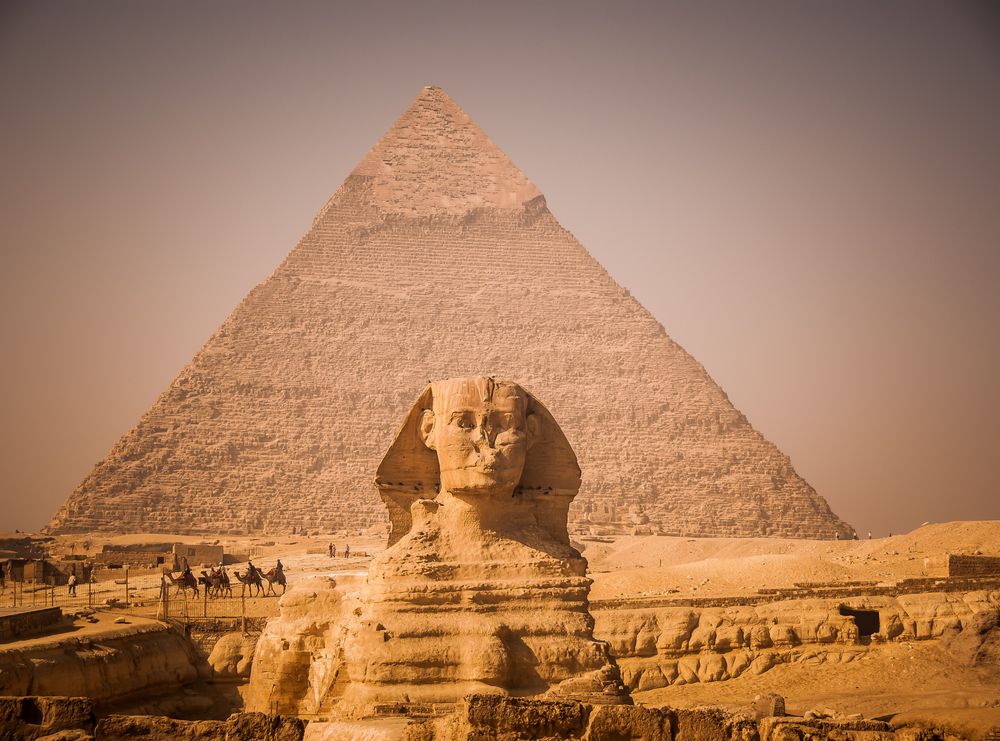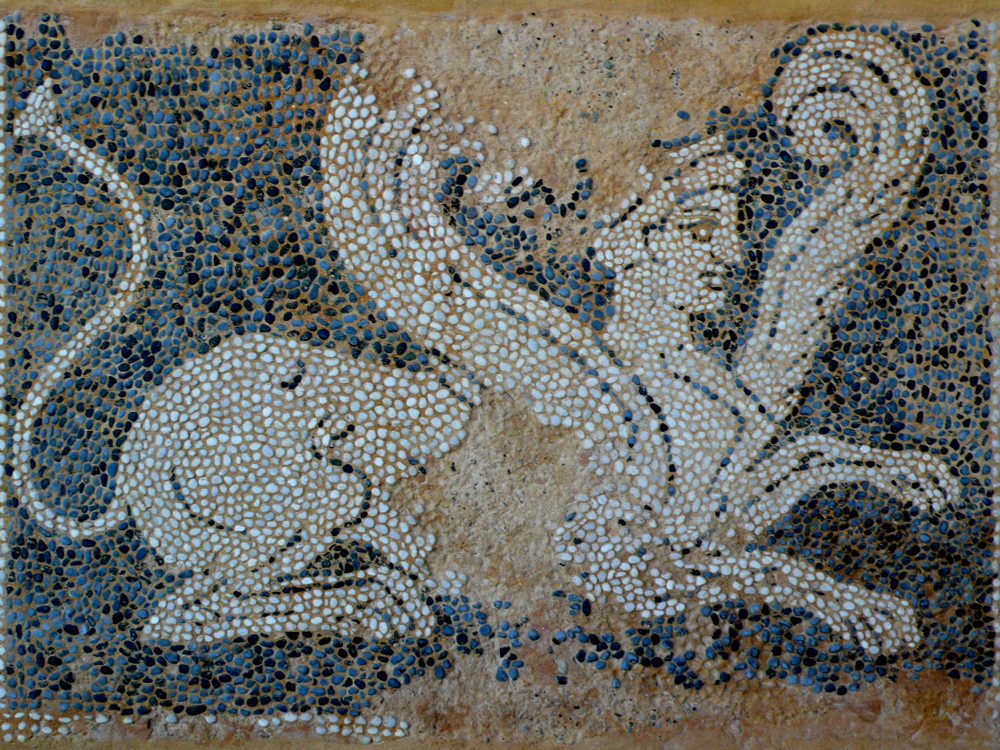Representing wisdom, power, and mystery, the Sphinx appears in various cultures, notably in Greek and Egyptian mythology. In this exploration, we'll delve into the myths, symbolism, and enduring fascination of this mythical creature.
Jump to:
What is a Sphinx?

A sphinx is a mythical creature with the head of a human and the body of a lion. This intriguing combination captures the essence of human intelligence and animal strength, making it a powerful symbol in ancient lore. The sphinx appears in various forms across different cultures, each adding unique elements to its depiction and story.
What does the Sphinx look like?
The iconic image of the sphinx typically features a human head, often adorned with royal headgear, and the muscular body of a lion. In Egyptian depictions, the sphinx is generally male and has a straightforward, regal posture, sitting with its paws stretched out in front. The Greek sphinx might include wings and is usually portrayed as more fearsome, sometimes with a female face.
Recommended for you!
Best SellersOrigins of the Sphinx

The Egyptian Connection
In Egyptian mythology, the sphinx is primarily a guardian figure, standing watch over temples and tombs. The Great Sphinx of Giza, with its mysterious smile, gazes eternally across the sands near the great pyramids. This monumental structure, possibly representing the Pharaoh Khafre, symbolises royal strength and wisdom. In this culture, the sphinx often embodies the god Harmakhet, linking the sun god Ra with the horizon.
The Greek Interpretation
The Greek version of the sphinx adds a twist to the tale, incorporating a bird's wings into the lion-human mix, enhancing its mystique. Greek narratives often depict the sphinx as a more dangerous entity. The most famous Greek myth involving the sphinx is set in the city of Thebes, where it terrorised the citizens by posing a deadly riddle.
The Sphinx’s Myths
The sphinx is a central figure in various cultural myths, and Greek stories particularly highlight its cryptic and ominous nature.
The Sphinx’s Riddle and Its Consequences
The legend of the sphinx's riddle is central to its mythology in Greek culture. The creature posed the following puzzle: "What walks on four feet in the morning, two in the afternoon, and three at night?"
This riddle was a matter of life and death. Those who failed to answer correctly were killed. Oedipus, a hero in Greek mythology, famously solved the riddle. He explained that humans crawl on all fours as infants (morning of life), walk on two feet as adults (afternoon), and use a walking stick in old age (evening). Upon hearing the correct answer, the sphinx, defeated, threw itself from a rock and died.
The Sphinx as the Challenger of Thebes
Before the arrival of Oedipus, the sphinx descended upon the city of Thebes, sent by the gods as a punishment for an ancient crime. The creature sat outside the city gates, posing its lethal riddle to all who wished to enter or leave and crippling the city under a reign of terror. This myth highlights the sphinx's role as a divine instrument of justice or vengeance, adding a layer of divine intervention to its tale.
The Sphinx and the Curse of the Royal House
In a lesser-known tale, the sphinx is said to have been involved indirectly in the curse of the royal house of Thebes. According to some versions, the sphinx was dispatched by Hera, a goddess often associated with matrimonial strife and jealousy, as a punishment towards the ruling family for a slight against her.
This myth connects the sphinx to the tragic destiny of Thebes' rulers, showing how the creature's influence extended beyond riddles to encompass the fates of kings and heroes.
The Duel of Sphinx and Anubis
A myth from a later period when Greek and Egyptian cultures intermingled features a contest between the sphinx and Anubis, the jackal-headed god of mummification. In this tale, the two beings competed to prove who was the superior protector of sacred sites.
While not part of the classical canon, this story illustrates how the sphinx was compared and contrasted with other guardian figures, symbolising its importance in myth as a keeper of sacred and secret knowledge.
Sphinx Symbolism Across Cultures
The sphinx, a captivating figure in mythology, symbolises many ideas across cultures, reflecting its varied roles in ancient societies.
Guardian of Mysteries
Egyptian Context: In Egypt, the sphinx guards sacred spaces, symbolising the pharaoh's might and wisdom, protecting sites from intruders.
Greek Context: In Greek mythology, the sphinx challenges the intellectual and moral qualities of heroes, acting as a guardian of knowledge and truths.
Symbol of Transformation
In Greek myths, the riddle of the sphinx is a metaphor for the human life cycle—crawling as infants, walking as adults, and using a cane in old age—symbolising growth and the inevitability of change. This positions the sphinx as a reminder of life’s mysteries and transformations.
The Sphinx Today: Cultural Impact and Relevance

The image of the sphinx continues to be a powerful symbol in modern times. It represents enigma, wisdom, and the guarding of secrets. Its figure adorns numerous monuments and has inspired countless works of art, maintaining its place in popular culture as a bridge between the known and the mysterious.
Frequently Asked Questions About the Sphinx
Is the Sphinx Egyptian or Greek?
The sphinx is a significant figure in both Egyptian and Greek mythology, but its origins are distinctly Egyptian. The concept travelled to Greece, where it was adapted with new mythologies and characteristics, such as wings and a more sinister role in stories like the riddle of Thebes.
Were there two Sphinxes?
While the most famous sphinx is the Great Sphinx of Giza in Egypt, sphinxes are not limited to single instances in myths or archaeological findings. Both Egyptian and Greek cultures have multiple depictions of sphinxes. However, the myths typically refer to a singular, notable sphinx, such as the one in the Oedipus legend.
Why does the Sphinx have a lion body?
The lion's body symbolises strength, royalty, and dominion over nature, embodying the king's role as a protector and ruler. This imagery was meant to evoke awe and respect, ensuring that the sphinx was seen as a powerful spiritual presence.
Is the Sphinx really Anubis?
The sphinx and Anubis are distinct entities in Egyptian mythology. Anubis is depicted as having the head of a jackal and is associated with mummification and the afterlife. The confusion might arise from their shared roles as protectors and their prominent animal features, but they represent different aspects of Egyptian religious beliefs.
What are 5 facts about the Sphinx?
- The Great Sphinx of Giza is one of the oldest known monumental sculptures, carved directly out of limestone around 4,500 years ago.
- Despite extensive studies, many details about the Sphinx’s construction and purpose remain subjects of debate among historians and archaeologists.
- The sphinx has represented sovereignty, wisdom, and strength, appearing in various forms in cultures beyond Egypt and Greece, including South and Southeast Asia.
- The Sphinx has undergone numerous restoration efforts over the centuries due to erosion and man-made damage.
- The sphinx has inspired countless artworks, literary works, and even modern films, maintaining its role as a symbol of mystery and ancient wisdom.
How many Sphinxes are there?
While there is only one famous Great Sphinx of Giza, sphinxes as a type of statue or mythical depiction can be found in many ancient cultures, including Egyptian, Greek, Persian, and South Asian. The number is not finite, as new archaeological discoveries can still be made.
What does the Sphinx represent?
The symbolism of the sphinx varies significantly between cultures. In Egyptian mythology, it is predominantly seen as a protective entity, guarding the sacred and the royal. Its presence near pyramids and temples serves as a spiritual guardian against any form of evil or disruption. In contrast, the Greek sphinx combines elements of danger and knowledge, representing a challenge to be overcome, embodying riddles and fatal consequences for those who fail to solve them.
What does the Great Sphinx of Giza look like today?
Over the millennia, the Great Sphinx of Giza has faced numerous challenges, including erosion, sand encroachment, and human interference, which have altered its original appearance. Its nose is famously missing, and while several legends suggest various causes, historical evidence points to deliberate vandalism. Despite these damages, the Great Sphinx continues to be a monumental and awe-inspiring figure, sitting majestically with its gaze eternally fixed on the eastern horizon, welcoming the sun.
Was the Sphinx originally Greek?
The concept of the sphinx was not originally Greek but was adopted into Greek mythology from the Egyptians. The ancient Greeks were greatly influenced by Egyptian culture during various periods of contact and subsequently incorporated many Egyptian elements into their own artistic and mythological traditions. The Greek version of the sphinx, however, was characterised by a more ominous role, demonstrating the Greeks' adaptation of the figure to fit their mythological narratives.
Is the Sphinx a male or a female?
In Egyptian context, the sphinx is generally considered male, often depicted as a composite of the reigning pharaoh and a lion, symbolising strength and wisdom. However, the Greek sphinx is typically portrayed as female, adding a layer of complexity and danger, often associated with the seductive yet destructive qualities that Greek mythology ascribed to female monsters, like the sirens and Medusa.
Were there Sphinxes in other cultures?
The concept of a sphinx or similar hybrid creatures appears in several other ancient cultures beyond Egypt and Greece. For example, in South Asian mythology, creatures resembling the sphinx are found in Hindu and Buddhist iconography, representing the protection of sacred spaces. The Persian Empire also had its own versions, showcasing the sphinx in art and sculpture, which often depicted them as part of royal imagery, highlighting their protective qualities.
What ongoing research or projects are focused on the Sphinx?
Archaeological and restoration efforts continue around the Great Sphinx of Giza and other sphinx statues worldwide. Modern technology, such as ground-penetrating radar and digital imaging techniques, has allowed archaeologists to study these ancient structures without harming their integrity. These projects aim to preserve them for future generations and potentially unlock more secrets about their construction, purpose, and the civilisations that built them.
Recommended for you!
Best SellersDiscover More with the Greek Mythology Diploma Course
If you're intrigued by the myths of the sphinx and wish to dive deeper into the legends of the ancients, enrol in our Greek Mythology Diploma Course. This course is designed to broaden your understanding of mythology's rich narratives and their significance in contemporary life.
Why Centre of Excellence?
- Accessibility: We believe education should be accessible to all, which is why we offer our courses at competitive prices to ensure everyone can join.
- Flexibility: Our courses are designed to fit your life. Learn at your own pace and on your own schedule, seamlessly integrating your education with your daily commitments.
- Broad Curriculum: Explore a vast range of topics within Greek mythology, delving into its complex characters and their stories that continue to fascinate and educate.
- Dedicated Support: Upon enrolment, you’ll receive personalised tutoring and join a community of like-minded learners, all supported by our dedicated team to help you succeed.
Special Invitation
Step into the world of gods and monsters with our Greek Mythology Diploma Course, now available for just £29—a saving of over £100!













